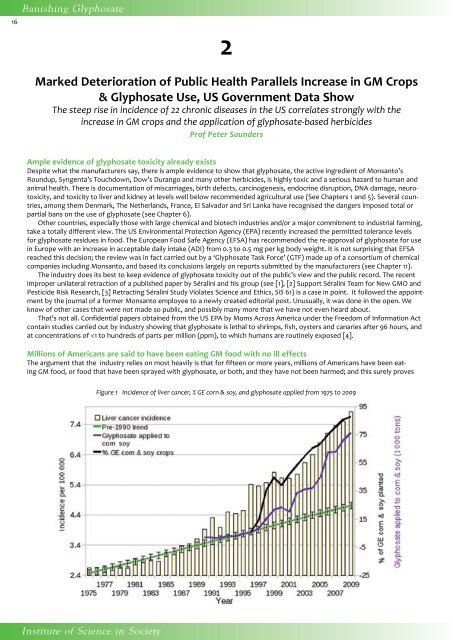Banishing Glyphosate
BanishingGlyphosate
BanishingGlyphosate
Create successful ePaper yourself
Turn your PDF publications into a flip-book with our unique Google optimized e-Paper software.
16<br />
<strong>Banishing</strong> <strong>Glyphosate</strong><br />
2<br />
Marked Deterioration of Public Health Parallels Increase in GM Crops<br />
& <strong>Glyphosate</strong> Use, US Government Data Show<br />
The steep rise in incidence of 22 chronic diseases in the US correlates strongly with the<br />
increase in GM crops and the application of glyphosate-based herbicides<br />
Prof Peter Saunders<br />
Ample evidence of glyphosate toxicity already exists<br />
Despite what the manufacturers say, there is ample evidence to show that glyphosate, the active ingredient of Monsanto’s<br />
Roundup, Syngenta’s Touchdown, Dow’s Durango and many other herbicides, is highly toxic and a serious hazard to human and<br />
animal health. There is documentation of miscarriages, birth defects, carcinogenesis, endocrine disruption, DNA damage, neurotoxicity,<br />
and toxicity to liver and kidney at levels well below recommended agricultural use (See Chapters 1 and 5). Several countries,<br />
among them Denmark, The Netherlands, France, El Salvador and Sri Lanka have recognised the dangers imposed total or<br />
partial bans on the use of glyphosate (see Chapter 6).<br />
Other countries, especially those with large chemical and biotech industries and/or a major commitment to industrial farming,<br />
take a totally different view. The US Environmental Protection Agency (EPA) recently increased the permitted tolerance levels<br />
for glyphosate residues in food. The European Food Safe Agency (EFSA) has recommended the re-approval of glyphosate for use<br />
in Europe with an increase in acceptable daily intake (ADI) from 0.3 to 0.5 mg per kg body weight. It is not surprising that EFSA<br />
reached this decision; the review was in fact carried out by a ‘<strong>Glyphosate</strong> Task Force’ (GTF) made up of a consortium of chemical<br />
companies including Monsanto, and based its conclusions largely on reports submitted by the manufacturers (see Chapter 11).<br />
The industry does its best to keep evidence of glyphosate toxicity out of the public’s view and the public record. The recent<br />
improper unilateral retraction of a published paper by Séralini and his group (see [1], [2] Support Séralini Team for New GMO and<br />
Pesticide Risk Research, [3] Retracting Séralini Study Violates Science and Ethics, SiS 61) is a case in point. It followed the appointment<br />
by the journal of a former Monsanto employee to a newly created editorial post. Unusually, it was done in the open. We<br />
know of other cases that were not made so public, and possibly many more that we have not even heard about.<br />
That’s not all. Confidential papers obtained from the US EPA by Moms Across America under the Freedom of Information Act<br />
contain studies carried out by industry showing that glyphosate is lethal to shrimps, fish, oysters and canaries after 96 hours, and<br />
at concentrations of


